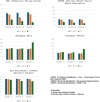Efficacy of extracorporeal shock wave therapy and nutraceutical supplementation in the treatment of lateral epicondylitis: a randomized controlled trial
- PMID: 40567345
- PMCID: PMC12187671
- DOI: 10.3389/fresc.2025.1593909
Efficacy of extracorporeal shock wave therapy and nutraceutical supplementation in the treatment of lateral epicondylitis: a randomized controlled trial
Abstract
Introduction: Numerous scientific papers have compared different treatment options in the management of lateral epicondylitis. Our study evaluated the efficacy of focal extracorporeal shock wave treatment (ESWT) combined with an integrative nutraceutical treatment of hyaluronic acid, collagen, vitamin C, and manganese, compared with single treatment in patients with lateral epicondylitis in terms of improvement of pain, functional capacity, muscle strength, and reduction of inflammation on ultrasound images.
Methods: A single-center, randomized controlled trial (RCT) was conducted in a population of patients with lateral epicondylitis. Patients were enrolled and randomly divided into 3 groups: Group A, consisting of 15 patients who were treated with twenty sessions of therapeutic exercise and five focal ESWT sessions (one session every six days); Group B, consisting of 15 patients who performed twenty sessions of therapeutic exercise and took daily a dietary supplement consisting of Hyaluronic Acid 200 mg, Collagen 5,000 mg, Vitamin C 250 mg and Manganese 10 mg for thirty days; and Group C, consisting of 15 patients, who received a combined treatment of therapeutic exercise, focal ESWT and nutraceutical supplementation The Numerical Rating Scale (NRS) and Patient-Rated Tennis Elbow Evaluation Scale (PRTEE) were administered during the first physiatric examination (T0), at 15 days after the start of treatment (T1), and at a 30-day follow-up (T2). In addition, muscle strength (Handgrip strength) was analyzed by means of a dynamometer, and common extensor tendon thickness (CET Thickness) by ultrasound examination.
Results: Data analysis showed that NRS scale scores decreased significantly only in group B at T1 (P < 0.05), and in the three groups at T2 (P < 0.05). Grip strength increased significantly after 30 days only in group C (P < 0.05), while PRTEE scores and CET Thickness decreased significantly at T2 in the three groups (P < 0.05). The comparison among the various groups also showed that the Group C showed statistically significant improvements of function and grip strength at T2, compared with the other groups (P < 0.05).
Discussion: Our study demonstrated that the combination of focal ESWT, therapeutic exercise, and nutraceutical supplementation, represent a viable therapeutic option for the management of lateral epicondylitis; likewise, the proposed treatments resulted in a synergistic effect for pain relief and functional recovery in the short term, providing a decrease in the inflammatory state and an increase in muscle strength.
Keywords: musculoskeletal disease; nutraceuticals Rehabilitation; tendinopathy; tennis elbow; ultrasonography.
© 2025 Scaturro, Migliorino, Tomasello, Vecchio, Moretti, Iolascon and Letizia Mauro.
Conflict of interest statement
The authors declare that the research was conducted in the absence of any commercial or financial relationships that could be construed as a potential conflict of interest. The author(s) declared that they were an editorial board member of Frontiers, at the time of submission. This had no impact on the peer review process and the final decision.
Figures
Similar articles
-
The Clinical Efficacy of Extracorporeal Shock Wave Therapy Combined With Platelet-Rich Plasma and Exercise for Lateral Epicondylitis: Prospective Randomized Sham-Controlled Ultrasonographic Study.Arch Phys Med Rehabil. 2025 Aug;106(8):1173-1182. doi: 10.1016/j.apmr.2025.01.420. Epub 2025 Jan 20. Arch Phys Med Rehabil. 2025. PMID: 39842562 Clinical Trial.
-
Focused shock wave and ultrasound therapies in the treatment of lateral epicondylitis - a randomized control trial.Sci Rep. 2024 Oct 30;14(1):26053. doi: 10.1038/s41598-024-77410-w. Sci Rep. 2024. PMID: 39472446 Free PMC article. Clinical Trial.
-
Extracorporeal Shock Wave Therapy Shows Superiority Over Injections for Pain Relief and Grip Strength Recovery in Lateral Epicondylitis: A Systematic Review and Network Meta-analysis.Arthroscopy. 2022 Jun;38(6):2018-2034.e12. doi: 10.1016/j.arthro.2022.01.025. Epub 2022 Jan 31. Arthroscopy. 2022. PMID: 35093494
-
Corticosteroids for the treatment of Duchenne muscular dystrophy.Cochrane Database Syst Rev. 2016 May 5;2016(5):CD003725. doi: 10.1002/14651858.CD003725.pub4. Cochrane Database Syst Rev. 2016. PMID: 27149418 Free PMC article.
-
Sertindole for schizophrenia.Cochrane Database Syst Rev. 2005 Jul 20;2005(3):CD001715. doi: 10.1002/14651858.CD001715.pub2. Cochrane Database Syst Rev. 2005. PMID: 16034864 Free PMC article.
References
LinkOut - more resources
Full Text Sources



